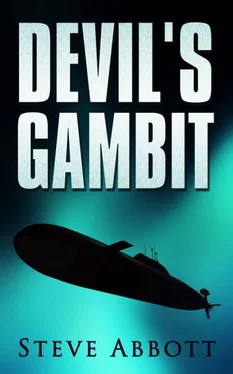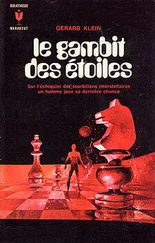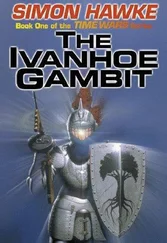At least naval support would not be a problem. The third fleet was already in the Straits of Korea, just in case. SEAL Team Three was on its way as well. As a contingency, they were bringing the Hind helicopter element of their OPFOR group. Gayle wasn’t sure what good the Hinds would be, but you never turn down anything offered by higher command. They might not offer it again. The last brief was the most welcome one of all. The man who had been in charge of securing materials for the North Korean nuclear program had defected. Gayle read through the brief bio of Chun Seng Kyun. The details of his escape were vague, but North Korean fatalities were mentioned.
The images on the Tactical Information display performed their intricate electronic ballet. Each small cluster of pixels was a ship or aircraft of Carrier Task Force 61. Bright red showed the cover zones of the AEW aircraft. Faint blue showed the projected ranges and arcs of the passive radar systems of ships under his command. Bright green lines and script were the ship or unit’s name, its speed and current heading and, if it was an aircraft, altitude.
Admiral Douglas Abrahams looked down at the symbols in the TID. It was a far cry from the multicolored grease-pencil markings on the acetate board maps of his youth. Abrahams preferred the chaotic scrawl of the past to the new clinical data transfer of the present. In the old days, the ships and crews had been small. If a plane was being scratched from the roster, you knew the man. There was a good chance you had met his wife and kids. It was a human touch. Now, computers read an IFF code and your ship or unit became just another code, a data packet. If you were lost, your file was deleted as a matter of routine. But with command came distance. It would be impossible for him to know each and every one of the five thousand men aboard this ship, let alone all the ships of his task force. Abrahams shook himself out of his reverie.
“Jesus, I’m getting morbid in my old age,” he thought.
CTF 61 formed a picket line that ran from the Korea Straight to one hundred miles past Cheju-Do Island in the Yellow Sea. The ship dots were spread pretty thin. Air cover was doing its best to fill in the gaps between the lines. His flagship, the Dwight D Eisenhower, was dead center, just behind and below the display’s illustrated picket line. This new display was state of the art. Far better than the older displays with their raster graphics and only four colors. Each ship type on the new display was represented by a different color and high definition. The Eisenhower’s symbol was a white box with a gold anchor superimposed on its center and CVN69 underneath. The anchor designated it the flagship. If the Eisenhower was damaged in combat and the Admiral was forced to leave the ship, the anchor would be moved to his next command vessel.
It had been fifty years since any Admiral had been forced to move his command during an engagement. Abrahams had sworn that would never happen to him. The new toys of naval combat made even the sixteen-inch guns of the big battle wagons pale in destructive capability. He scanned the display, looking for the dark shark-gray shapes of his subs, a color Abrahams felt was most fitting. They were, after all, his sharks, cruising the depths looking for unsuspecting prey. Their mission premise made the indicated plots on his display a rough guess at best.
The Eisenhower had been at a state of General Quarters for almost a week. The atmosphere in the Combat Information Center was fifty percent caffeine and fifty percent adrenaline. It was taking a visible toll on the carrier’s crew and command staff.
The North and South of Korea were once again at a state of high alert. A series of priority orders and briefings from the Pentagon and CINCPAC had moved his ship from her normal state of alert for this region from DEFCON 4 to DEFCON 2. DEFCON 2 was right on the edge of a full on shooting war.
Abrahams had been through the long protracted conflict of the Vietnam War as a very young Lieutenant on board a Destroyer Escort. He had little wish to see his country resume hostilities with the North Koreans. He considered the South recalcitrant in its duties. Another Asian megalith that flooded the States with expensive smartphones and useless luxury items at the expense of human rights. The Admiral felt wars in the Far East were better left to combatants who had a physical claim to the region. Combatants with the ability to move their own men and materials into any ensuing fray. The Far East had expulsed more invaders from different parts of the world than history could or cared to remember.
Abrahams was not an isolationist. He merely loved his country and hated the effect that unchecked trade of American jobs for cheaper manufacturing costs was having on companies and technology that had made America great. There was a deeper, darker reason: the personal aftermath of another later regional war. A war fought against a rarely seen enemy who left nothing but booby traps and carnage in its wake. His son had returned from Afghanistan minus the lower half of his left leg and part of his left hand thanks to an IED. Fortunes of war.
DEFCON 2 was a weapons free situation. At his or the Commanding Deck Officer’s discretion, any craft approaching by sea or air that failed to identify itself with proper IFF codes would be destroyed by his air cover or ship-launched missiles and Phalanx fire. Two groups of F-18 Hornet fighters were providing BARCAP. The Barrier Combat Air Patrol line was set at twelve miles from his task force. Four E2C Hawkeyes provided Airborne Early Warning capability, as well as Command, Control, Communication and Intelligence, called simply C 3I. The Hornets were the warning buzz and, if needed, the sting of the Carrier’s Task Force, BARCAP. The eight aircraft provided protection to all ships over the entire far flung length of the picket line.
There would be no repeat of the USS Stark disaster on Abraham’s watch. If any object moved within the Eisenhower’s sphere, it would be tracked. If it proved to be hostile, it would be destroyed.
To the north, outside his narrow picket line, closer to the shores of North Korea, a series of small blips indicated DPRK naval units. The number of real combatant ships in the North’s arsenal were unconfirmed. The North had a few aging Soviet- and Chinese-built Destroyers and Frigates. Most of their inventory was made up by small, Fast Attack Missile boats. A concept the Russians had always embraced and the Americans had shunned since the Second World War. A surprising move considering the success of the PT and MTB boats of the US and British Navies during that period.
Small missile boats could launch swarms of anti-ship missiles and decoys to fool countermeasures. A well-concerted attack by a force of them and one or more of the ships under his command could go to the bottom in a hurry. Abrahams wished that he at least had some Corvettes to round out his forces and engage the Koreans in shallower waters if the need should arise. But the Navy had a thing about size, and a Corvette was not a very sexy ship. The result? Over time, they had gotten into the world’s most expensive pissing match in naval forces. He knew the logic behind creating such an apparently weak force. If your country wasn’t operating in deep blue water but the so called brown water of your coastline and estuaries, they were the cheap and cost effective alternative. With enough mosquitoes, even the blood of an elephant could be drained. It frustrated nearly all of the bridge crew. All they could do was spy on the naval forces of the North. Defense satellites and observation aircraft equipped with their synthetic aperture, side-looking radars gave an accurate idea of the North’s shore line defenses. Any ship caught in the cone of detection could later have its radar cross section analyzed to determine its type and purpose. Being forewarned was being forearmed.
Читать дальше












